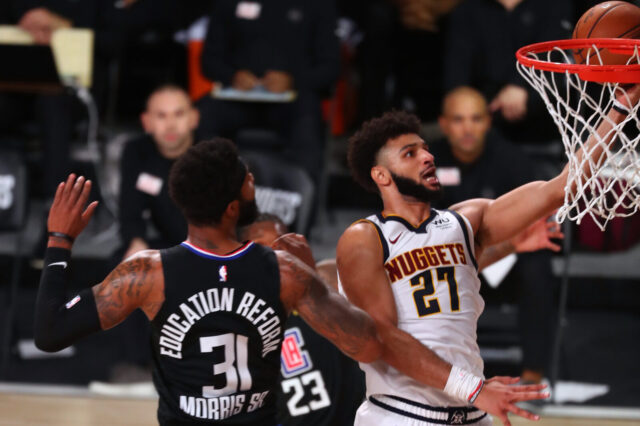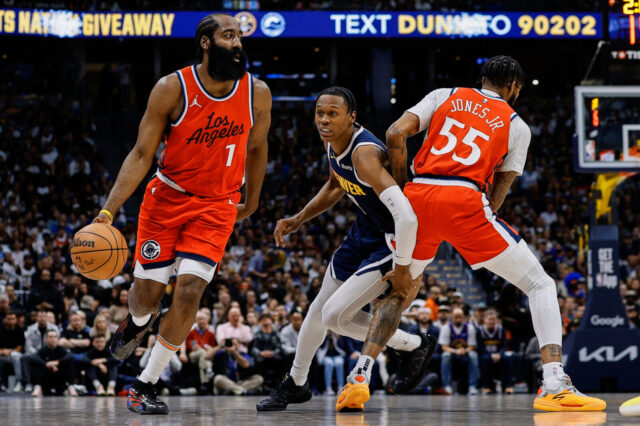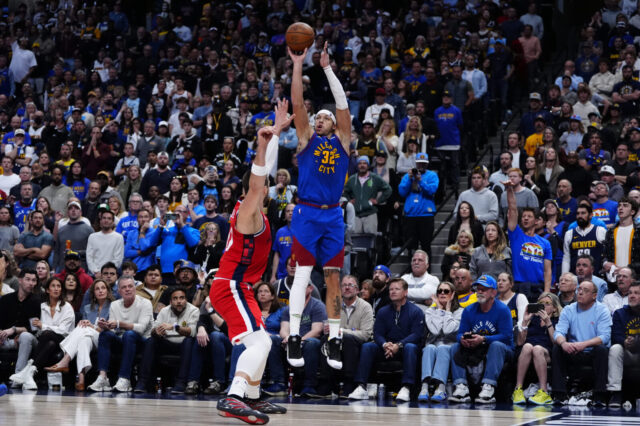Making the easy read
Malik Beasley has turned into a very solid rotation piece for the Denver Nuggets this season and a key reason why the Nuggets’ bench unit has been such a positive through the first 20 games of the season. Beasley entered the league with the talent and athleticism to be an NBA player but he was held back by his decision making and general feel for the game. One reason he has been able to break out this season is because he has simplified things on the offensive end. For the most part, he shoots when he is open, swings the ball when he is not, and plays with a lot of energy and effort on rebounds and in transition.
Moments like the one from the clip below happen much more infrequently than they had in the past (even as recently as summer league) but still highlights the type of over-aggressiveness and narrow focus that can get him into trouble. After making an excellent hustle play on the defensive end, Beasley zeroes in on the rim, completely missing the easy swing pass to a wide open Gary Harris. Bonus: Watch Monte Morris attempt to direct Beasley to the open man.
Trey Lyles struggles with this too, at times. Lyles is a scorer first and foremost and is usually at his best when he is looking to score every time he touches the ball. But that aggressiveness has to be balanced out to some degree by the ability to identify double-teams as quickly as possible. In the clip above, he catches a double-team at the best spot on the floor to receive a double-team, the top of the three-point arc. This means that there are just three Timberwolves players to guard the wings, corners, and paint. A quicker recognition would’ve led to an excellent shot with great position for an offensive rebound.
Freezing the rim protector in the PnR
One of the keys for a point guard to successfully operate out of the PnR is to learn how to force the rim protector to commit to an assignment. As the point guard turns the corner in the PnR, the drop big is tasked with playing in between the ball and the big rolling to the rim. His goal is often to wait as long as he can to fully commit to one or the other. Clever defensive bigs are even able to fake one direction to lure the guard into a bad read. Athletic bigs are able to wait until the last second to make the decision, forcing the guard into difficult split-second decisions.
In the first clip below, Monte Morris does a crafty job of freezing the drop big. As he turns the corner on the screen, Monte keeps his dribble alive while slowing down and waiting for Nikola Jokic to roll further toward the basket. The defender freezes for a moment as he gets caught between walling off Morris and recovering back to Jokic and that opens a window for Morris to score the easy reverse.
Contrast that to Murray who sprints off of the screen toward one of his favorite spots, the left elbow. However, his defender is long and athletic and able to close out on him to take away the pull-up jumper. Meanwhile, Karl-Anthony Towns is let off of the hook, never having to commit toward either Murray or Mason Plumlee who is rolling hard to the rim and calling for the lob.
Murray plays fairly conservatively as a passer in the PnR, knowing that turnovers are far more costly than dropoff passes are beneficial, but as he gains more experience, he’ll need to learn to take advantage of the possessions when a big fails to commit to the ball. Keeping his dribble alive and taking an extra step toward the basket would likely force Towns to leaving Plumlee open for the dropoff or offensive rebound.
Paul Millsap: Weak side flare thrower
I’ve talked about this before but my favorite use for Paul Millsap on the offensive end alongside Jokic is as a weak side, heat-seeking missile of a screen setter. In the clip below, he recognizes a flare opportunity that arises out of Denver’s free-flowing offense. With Murray attacking the middle of the court out the PnR, the weak side wing defender becomes susceptible to these sort of blindside screens.
The timing on these screens is important. The screener will want to wait for the exact moment that the ball-handler turns the corner on the screen in order to penalize the wing defender for attempting to stunt over and help on the drive. Millsap does a great job of recognizing this opportunity and it results in a wide open three point shot.
Millsap spends a lot of time around the three-point arc as a floor-spacer and down in the dunker spot as a dropoff threat and offensive rebounder but my favorite spot for him to play is along the opposite elbow where he can lean on help side defenders and pick spots to set these types of flare screens.
Favorite play
The Oklahoma City Thunder do a somewhat unusual thing in the PnR. Because their two lead guards are so quick off of the dribble, they will often setup a PnR but have the screener set the ball screen on his own defender, rather than on the on-ball defender.
In the clip above, Paul George gets away with a bit of an illegal screen but you can see how quickly everyone’s defensive assignments change with this action. Beasley would typically be tasked with switching this screen and taking Westbrook. something both he and Morris anticipate as George begins to wander up to set the screen. But when George instead sets the screen on Beasley, both guys have to recalibrate. Morris does a nice job of sticking with the play but once Dennis Schroder gets a head of steam, there isn’t much Denver can do to stop them.
Nice play design.


